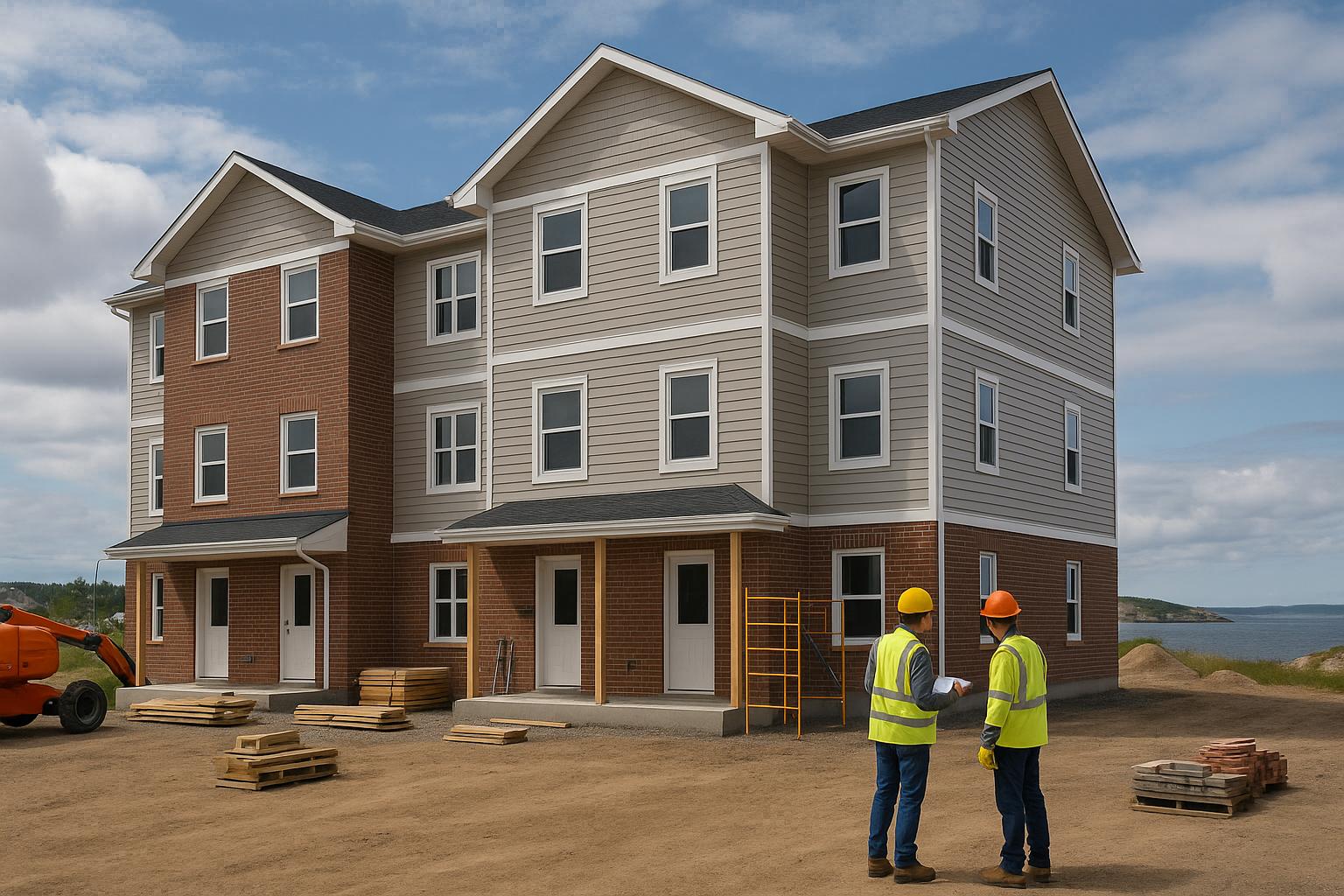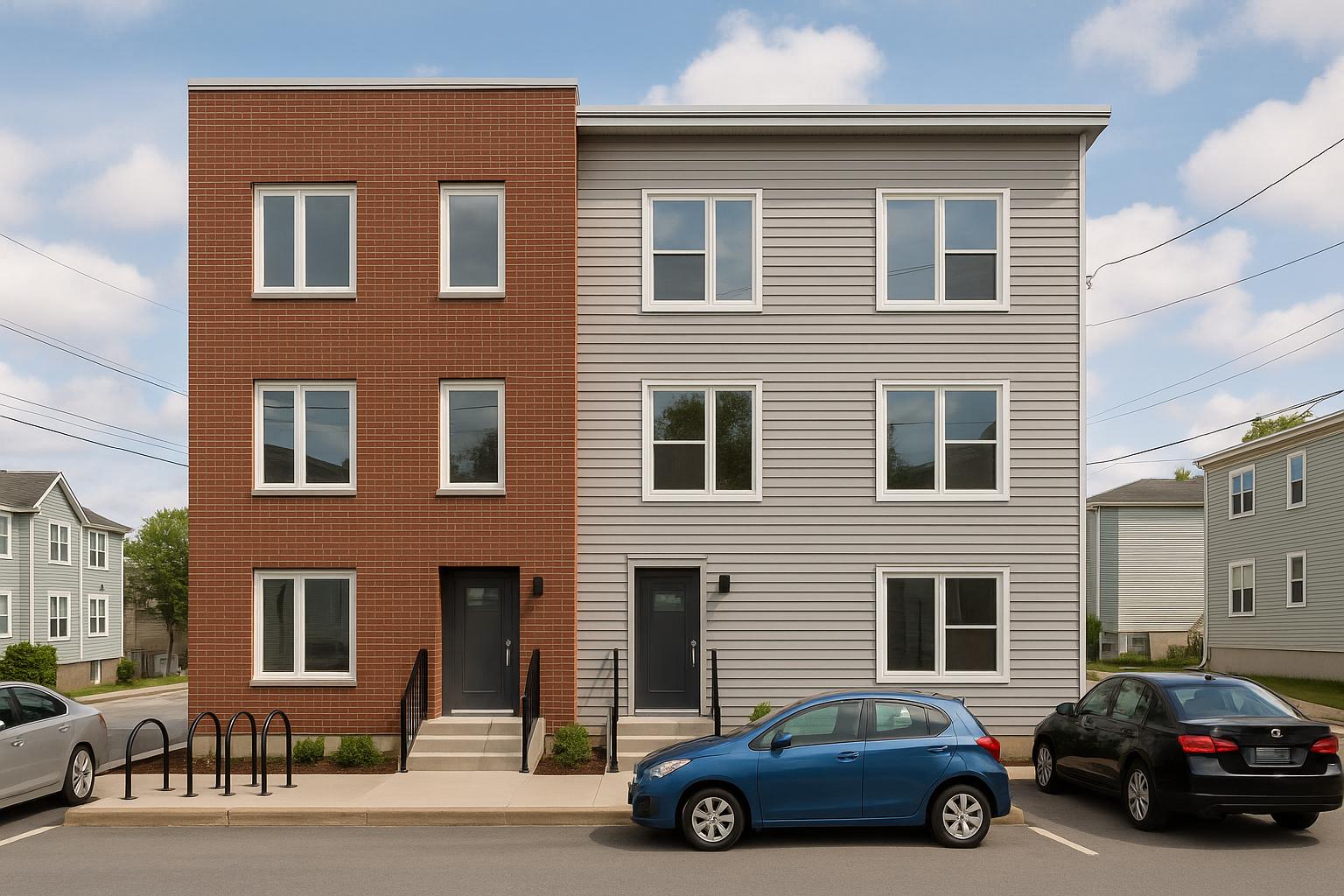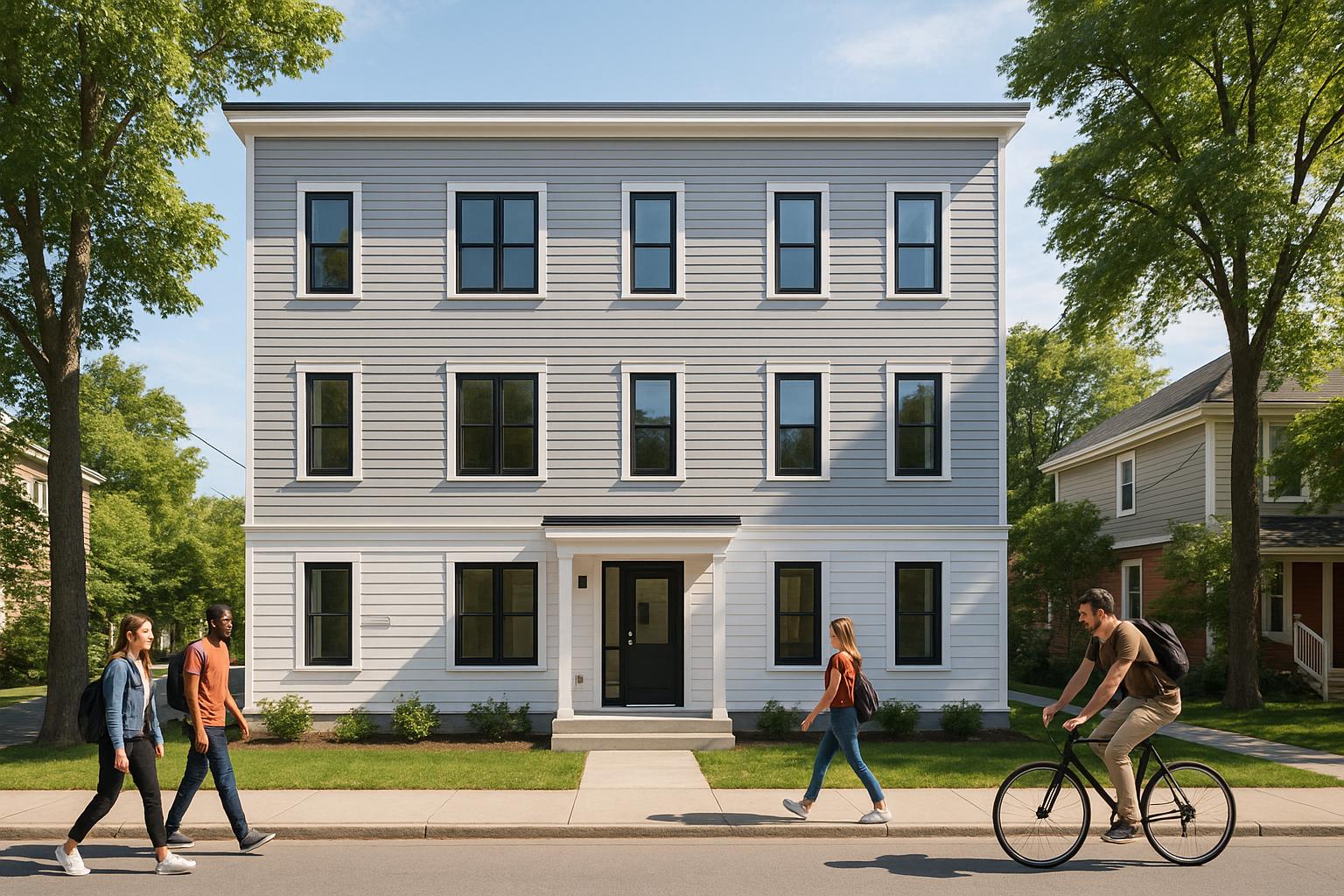Halifax has eliminated mandatory parking minimums for residential developments in the Urban Service Area. This means developers are no longer required to include a set number of parking spaces per unit. Instead, parking decisions are now market-driven, allowing for cost savings, increased housing density, and better land use. Key takeaways:
- Lower Costs: Developers save on parking infrastructure, cutting construction expenses by up to $50,000 per space.
- More Housing: Space previously used for parking can now accommodate more rental units.
- Simplified Approvals: Faster project approvals with fewer regulatory hurdles.
- Remaining Rules: Accessible parking, emergency access, and bicycle parking requirements still apply.
This policy change aligns with Halifax’s broader goals to reduce housing costs and promote transit-friendly urban growth.
110-112 Portland Street , Downtown Dartmouth, Nova Scotia/ Development Opportunity
How Zero Parking Minimums Impact Multi-Unit Rental Construction
Getting rid of parking minimums can reshape multi-unit rental construction by cutting costs, making better use of land, and increasing rental unit density - all of which contribute to higher returns for property owners.
Lower Construction Costs
When parking requirements are removed, developers can sidestep the hefty costs tied to building and maintaining parking facilities. Instead of spending on excavation or surface preparation for parking lots, that money can go toward building better-quality units or adding more of them. Plus, without ongoing expenses like snow clearing or parking lot repairs, owners can redirect their resources to upgrades that improve tenant satisfaction and boost revenue.
Smarter Land Use
No parking minimums mean developers can use every square metre of a site more effectively. Space that would have gone to parking can now be used for additional rental units or outdoor features like green spaces or patios. This flexibility is especially valuable in cities, where many renters rely on walking, cycling, or public transit. Features like secure bike storage take up far less room than parking spots, giving developers even more options to enhance the property’s appeal. By maximizing land use, developers can build more units, which directly impacts their bottom line.
Increased Rental Unit Density
Perhaps the biggest win is the ability to add more rental units. Without parking minimums, a property that might have been limited to four units could fit six instead. For example, if high-quality two-bedroom units rent for $1,950 to $2,100 per month, adding two extra units could bring in an additional $46,800 to $50,400 annually.
To fully take advantage of these density gains, working with an integrated design-build team is key. This approach ensures that the design and construction processes are aligned from the start, avoiding the delays and budget overruns that can happen when different professionals work independently. By streamlining the project, developers can maximize the benefits of higher density, leading to stronger long-term returns on investment.
Project Approvals and Regulatory Compliance
Halifax’s decision to eliminate minimum parking requirements has simplified the approval process for multi-unit residential projects. However, property owners still need to follow essential site and parking regulations.
Faster Approval Processes
By removing parking minimums, developers no longer have to request variances tied to parking counts. This change eliminates the need for complex parking studies and lengthy reviews. With fewer hurdles, design-build teams can focus on optimizing layouts and increasing unit density. At the same time, they can ensure that critical safety and accessibility standards are met.
Key Parking-Related Regulations
Although the approval process is faster, certain parking-related rules remain in place to ensure safety and accessibility:
- Accessible Parking: Spaces for individuals with disabilities are still required under provincial building codes and federal accessibility standards. These spaces must meet specific size and location criteria to accommodate all users effectively.
- Emergency Access: Developers must maintain proper road widths, turning radii, and clear zones to allow emergency vehicles to navigate the site.
- Additional Requirements: Local guidelines may still mandate provisions like bicycle parking or visitor parking. It’s crucial to review these requirements early in the planning stages.
Provincial Planning Updates
These changes align with broader provincial efforts to reduce regulatory barriers that can inflate construction costs and limit development density. Recent initiatives promote efficient land use, supporting higher-density residential projects and increasing housing supply. By eliminating parking minimums, Halifax is fostering transit-oriented developments and creating a more predictable regulatory environment for property owners. This approach encourages smarter, higher-density growth throughout the region.
Financial Benefits for Property Owners
Halifax's decision to eliminate minimum parking requirements opens up new financial opportunities for property owners developing multi-unit rental properties. This shift in regulations not only simplifies project planning but also enhances potential rental income and improves overall project efficiency.
Budget Planning and Cost Savings
With no mandatory parking requirements, property owners can reallocate funds that would have gone toward parking infrastructure. This means fewer costs tied to site preparation and more room in the budget for upgrades that enhance the property's appeal, such as modern amenities or energy-efficient systems. These smart reinvestments can significantly improve the property's marketability and operational performance.
Comparing Construction Approaches
When taking advantage of Halifax's updated parking policies, property owners face a key decision: stick with traditional construction methods or opt for an integrated design-build approach. The choice has a major impact on both timelines and budget predictability.
| Factor | Traditional Construction | Integrated Design-Build |
|---|---|---|
| Pricing Structure | Cost-plus with frequent changes | Fixed price before construction starts |
| Timeline Certainty | 12–18 months with common delays | 6 months with financial guarantees |
| Coordination | Owner manages multiple contractors | Single company handles all aspects |
| Budget Overruns | Average 30–60% over initial estimates | Contractually locked pricing |
| Quality Control | Multiple inspection standards | Triple verification with P.Eng oversight |
| Accountability | Finger-pointing among trades | Single point of responsibility |
Traditional construction often involves juggling several contractors, leading to delays and unexpected costs. By contrast, integrated design-build firms streamline the process by combining all services under one contract. This approach not only reduces headaches but also saves property owners an average of $47,000 by cutting down on coordination inefficiencies and avoiding costly change orders.
By simplifying project management, this method helps property owners stay on budget and finish projects faster, directly impacting rental income potential.
ROI and Rental Income Optimisation
The removal of parking minimums allows property owners to increase the number of rental units on a given property, making better use of available space. For example, a lot initially planned for a fourplex could be reimagined to include additional units. With rental rates averaging around $2,000 per month, even one or two extra units can significantly boost annual income.
Additionally, choosing an integrated design-build approach accelerates the construction timeline, enabling property owners to start collecting rent sooner. Projects completed in as little as six months - compared to the usual 12–18 months with traditional methods - can generate early cash flow of about $8,800 per month. Over a year, this adds up to $105,600 in additional income. Combined with fixed-price contracts and annual ROI rates of up to 20%, this approach offers property owners a reliable path to financial growth and reinvestment opportunities for future developments.
Case Studies: Zero Parking Minimums in Practice
Halifax provides a clear example of how property owners can make better use of land, lower construction expenses, and increase unit density by doing away with mandatory parking requirements.
Real-World Project Examples
Starting in early 2024, Halifax's updated zoning rules will allow property owners to use land more efficiently. Under the new ER-3 zoning - now the city’s most common residential designation - properties can include up to eight units without having to allocate space for parking [1]. This shift offers major cost savings. Creating surface parking spaces typically costs around CA$5,000 each, while building multilevel parking can climb to a staggering CA$50,000 per space [2]. By cutting out these costs, property owners can redirect funds toward features like high-quality finishes and design improvements that can attract higher rents. These changes set the stage for how a design-build approach can further enhance these savings.
Results from Integrated Design-Build Projects
Helio Urban Development has shown how an integrated design-build approach can maximize the advantages of zero parking minimums. With 31 units currently under construction and 131 more in the pipeline, Helio’s approach simplifies the process, reduces coordination issues, and keeps costs steady. For example, a fourplex project that eliminated parking requirements was completed at a fixed cost of CA$160,000 per unit in just six months - much faster than traditional methods. This quicker timeline allowed the property owner to start generating rental income significantly earlier than expected.
Lloyd Liu, co-founder of Helio Urban Development, notes, "Eliminating parking minimums allows us to focus construction budgets on features that actually generate rental income. Instead of spending $25,000 on parking spaces, property owners can invest in premium finishes that command higher rents."
By reallocating funds from parking infrastructure to energy-efficient upgrades and high-end finishes, property owners can increase both property value and annual returns. This efficient approach offers practical benefits, especially for newer builders.
Practical Scenarios for Emerging Builders
For a first-time developer planning a fourplex in Halifax, the elimination of parking minimums means no need to allocate land for parking lots, cutting down on costs for site preparation and paving. The saved space can be used to expand the building footprint, potentially adding more units, or to create shared amenities that justify higher rents.
For instance, the addition of an extra rental unit or the creation of inviting communal spaces can increase overall rental income and improve the property’s financial performance. By adopting an integrated design-build strategy, developers not only reduce costs but also speed up construction timelines, allowing rental revenue to start flowing sooner than with traditional methods.
Halifax’s new parking policies clearly pave the way for property owners to build more efficiently. By shifting resources away from parking infrastructure and towards features that enhance rental income and property value, these changes create exciting opportunities for both experienced developers and newcomers alike.
sbb-itb-16b8a48
Conclusion: Taking Advantage of New Opportunities
Halifax's decision to eliminate minimum parking requirements opens the door for exciting possibilities in multi-unit residential development. By no longer needing to dedicate valuable land and construction budgets to mandatory parking spaces, developers can achieve substantial cost savings and improve their overall return on investment.
These savings can be redirected into areas that add more value to a project. For instance, developers might invest in energy-efficient systems, better-quality finishes, or even additional rental units - enhancements that not only increase cash flow but also boost the long-term value of their properties.
Beyond the financial benefits, the absence of parking requirements simplifies the development process. With fewer regulatory hurdles, projects can move through approvals faster, allowing developers to focus on increasing unit density and refining building designs. This shift mirrors a growing trend across North America, where roughly 20% of over 3,000 municipal codes have already reduced or removed parking mandates entirely [4].
It’s important to note that while parking requirements are gone, regulations for safety and accessibility remain intact [3]. Engaging with municipal planning staff early in the process ensures compliance with these essential standards. This change reflects a broader movement towards more efficient and revenue-oriented development strategies.
Halifax’s parking reform isn’t just about cutting outdated rules - it’s about unlocking potential that was previously tied up in costly, underused infrastructure. By adopting an integrated design-build approach, developers can maximize these benefits. Those who act now can create smarter, more profitable rental properties while spending less on infrastructure that doesn’t generate revenue.
FAQs
How does removing parking minimums in Halifax affect the cost and timeline of building multi-unit residential properties?
Eliminating parking minimums in Halifax cuts down development costs by removing the need for costly parking facilities and the extra land they require. This shift can save property owners thousands of dollars per unit, making new projects more budget-friendly.
On top of that, it speeds up project timelines by simplifying the planning and approval process. Multi-unit rental developments, like fourplexes or larger buildings, can often be completed much quicker - sometimes in as little as six months - because there are fewer regulatory barriers. This approach lets property owners make better use of available land, add more rental units, and see quicker returns on their investments in Halifax's competitive rental market.
What parking-related rules still apply to developers in Halifax’s Urban Service Area, even with no minimum parking requirements?
Parking Requirements and Other Regulations in Halifax
Halifax's Urban Service Area no longer enforces minimum parking requirements for residential developments. However, developers still need to adhere to other municipal rules. These include regulations around garbage screening, maximum building heights, and various zoning and land-use requirements.
Even though parking isn't mandatory, it's crucial to ensure your project complies with these remaining guidelines to prevent delays or issues during the approval process. Take time to review the latest zoning bylaws and consider consulting local professionals for guidance.
How can property owners in Halifax use the new parking policy and design-build approach to boost rental income and ROI?
Halifax's Zero Minimum Parking Requirements: A Game Changer for Property Owners
Halifax’s decision to eliminate minimum parking requirements is more than just a policy shift - it’s a financial opportunity for property owners. By removing the obligation to include unnecessary parking spaces, developers can significantly cut construction costs. These savings can then be channelled into features that draw in tenants, like upgraded amenities or even additional rental units. The result? Increased rental income and a boost in property value.
The potential doesn’t stop there. Halifax’s ER-3 zoning allows up to eight units per lot, enabling developers to make the most out of the land they have. This zoning flexibility opens the door to more efficient and profitable use of space.
Streamlining Construction with an Integrated Design-Build Approach
An integrated design-build approach simplifies the construction process by combining design and construction into a single, seamless workflow. This method can shrink project timelines to as little as six months, helping property owners avoid unexpected delays and additional costs. By speeding up the process, owners can start generating rental income sooner while keeping financial risks in check.
When paired with Halifax’s progressive policies, this approach offers a practical and efficient way for property owners to thrive in the city’s competitive rental market.



